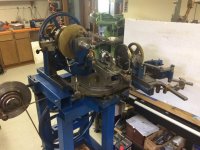I have a machine with some badly worn ... ummm, ... bevel gears ... that I would like to replace by making them myself. Does anyone have experience with these kinds of gears that engage under a variable shaft angle? The picture shows the engagement, just for illustration purposes, at about 15º from parallel. Machine constraints only allow a max of about 70º of shaft angle (from parallel) so they engage pretty much on the corner at that setting. The big messed up screw head shown between the gears is the pivot axis for setting shaft angle. The gears are roughly 2.5 inches diameter. It seems to me that backlash would vary as well since the variable angle engagement is not spherical but some variation (don't know how much yet) would be tolerable.
Would it be as simple as:
determine pitch angle for the bevel
determine pressure angle
cut the blank with a standard gear cutter paying attention to the cone angles on the beveled face.
??
Maybe somehow chamfer or radius the edge between the spur and the bevel?
I'm throwing out gear terms and I hope I'm not too far off base with them.
These are brass and there is little load on them and they operate at less then 20 -30 RPM.
Thanks for any thoughts!
Rich

Would it be as simple as:
determine pitch angle for the bevel
determine pressure angle
cut the blank with a standard gear cutter paying attention to the cone angles on the beveled face.
??
Maybe somehow chamfer or radius the edge between the spur and the bevel?
I'm throwing out gear terms and I hope I'm not too far off base with them.
These are brass and there is little load on them and they operate at less then 20 -30 RPM.
Thanks for any thoughts!
Rich





 Yep! It's a very old design evidently well before advances in non-linear drive technology. Yes, I will be using this machine. At the rate I'd be using it, a re-done crappy design will still last me a long time. I appreciate your thoughts on the matter (I had many of the same) and the potential solutions
Yep! It's a very old design evidently well before advances in non-linear drive technology. Yes, I will be using this machine. At the rate I'd be using it, a re-done crappy design will still last me a long time. I appreciate your thoughts on the matter (I had many of the same) and the potential solutions 
